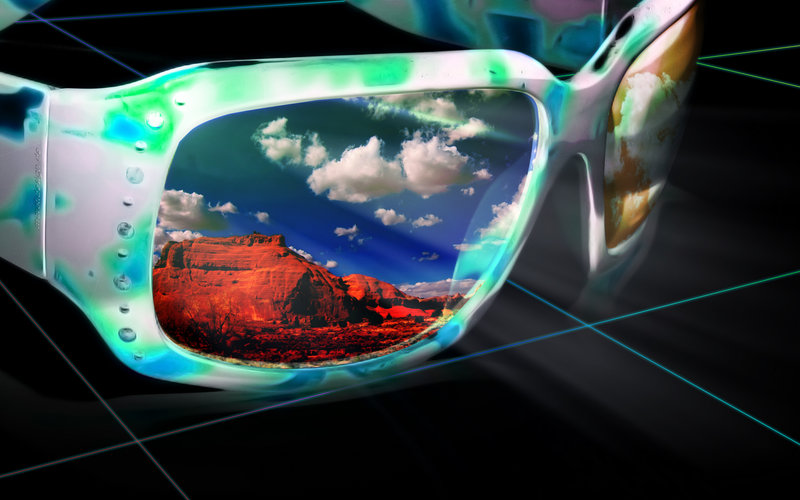Today technology has reached out to such an extent that it makes us possible to create our own imaginary world wherein an artificial world is created which looks similar to the real world. All these attribute to the invention of computers which have made this possible to a reasonable extent. One such technology in today’s world is the Virtual Reality. ‘Virtual’ in a layman’s language means something artificial and which does not exist in reality.
What does it mean?
 A three-dimensional artificial environment which can be created using computer hardware and software and presented to the user in such a way that it appears and feels like a real environment is called as Virtual Reality. A person who uses such an environment can enter into the computer generated virtual environment with the help of special gloves, goggles, ear phones etc… All these special devices make use of sensors which help in detection of the required signals. Virtual reality can be text-based or graphical based representation.
A three-dimensional artificial environment which can be created using computer hardware and software and presented to the user in such a way that it appears and feels like a real environment is called as Virtual Reality. A person who uses such an environment can enter into the computer generated virtual environment with the help of special gloves, goggles, ear phones etc… All these special devices make use of sensors which help in detection of the required signals. Virtual reality can be text-based or graphical based representation.
How does it work?
Virtual reality basically works on two requirements i.e. the number of frames which are to be rendered each second which is normally 10 frames per second or greater and the other is how fast the interactive objects within the virtual environment respond to the input commands given by the user. A system which is well equipped with the above too requirements can create a fast and robust virtual environment. Virtual reality systems can be classified into three categories ;
Desktop VR (Window on a World)
Desktop VR is when a computer user views a virtual environment through one or more computer screens. A user can then interact with that environment, but is not immersed in it. Desktop VR focuses on mouse, joystick, or space/sensor ball-controlled navigation through a 3D environment on a graphics monitor under computer control.
Video Mapping VR
Video Mapping VR uses cameras to project an image of the user into the computer program, thus creating a 2D computer character. Although fully immersed in the environment, it is difficult to interact with the user’s surroundings.
Immersive VR
Immersive VR uses a HMD(Head Mount Display) to project video directly in front of the user’s eyes, plays audio directly into the user’s ears and can track the whereabouts of the user’s head. Then a data glove (or data suit) is used to track movements of the user’s body and then duplicate them in the virtual environment. When the user cannot distinguish between what is real and what is not, then immersive VR has succeeded.

It all depends on how powerful a computer is to render the 3-D images in real-time by using sensors and input devices which the users can use to interact with virtual environment.
Where is it used?
Virtual reality has found itself being used in a wide variety of applications such as Gaming, Education, Astronomy, Medicine, Movies, and Therapy etc… Gaming uses artificial characters within the virtual environment and the movement of the characters is controlled by different kinds of hardware as well as software. Education is another area which has adopted virtual reality for teaching and learning situations. The advantage of this is that it enables large groups of students to interact with each other as well as within a three dimensional environment which helps in presenting complex data in an easily accessible way by making it more fun and easy to learn. War training is one such example which is increasingly using virtual reality environments to train the soldiers especially where actual availability of the resources is not feasible. Flight Simulators or the Submarine Simulators are few of the VR tools which are used to create the virtual environment in order to train the soldiers.
Advantages and Disadvantages
Virtual reality is a technologically advanced world which was built by scientists and programmers. One advantage to virtual reality is that it can train students or other professionals without putting them in danger in situations wherein people’s lives are in jeopardy. One disadvantage is that this technology can be costly as it requires high quality devices and sensors.
Future of Virtual Reality

There seems to be little doubt among thinkers of the social impact of VR, as much as television has, and the Internet is, regarding playing its own part in the power games of our time. But like everything, humankind will adapt by necessity. From health to education, torture to war, and art to government; virtual reality will increasingly make its presence felt and change the way we perceive things.
“As time goes on, so the technology will progress, and move further away from its original aims, rather like gunpowder. Virtual reality started in the abstract, and then moved on to war; perhaps ultimately it will bring peace.” (Sherman and Judkins)
In the future we will only be limited by our imagination regarding the uses of virtual reality. Thus it is neither good not bad, but rather what we make of it.
“It could be a lifesaving godsend, a groundbreaking educational tool, a means of becoming out best selves. Or, it could be a mindless, energy-sapping diversion, an off-ramp to electronic isolation, a playground for immortality. Chances are, it will be all of these things.” (Kershner)
References:
http://www.nas.nasa.gov/Software/VWT/vr.html
http://www.bilawchuk.com/mark/prosandcons.html
http://www.vrs.org.uk/virtual-reality-education/index.html
http://www.ask.com/question/disadvantages-of-virtual-reality
http://scholar.lib.vt.edu/ejournals/JITE/v41n4/ausburn.html






